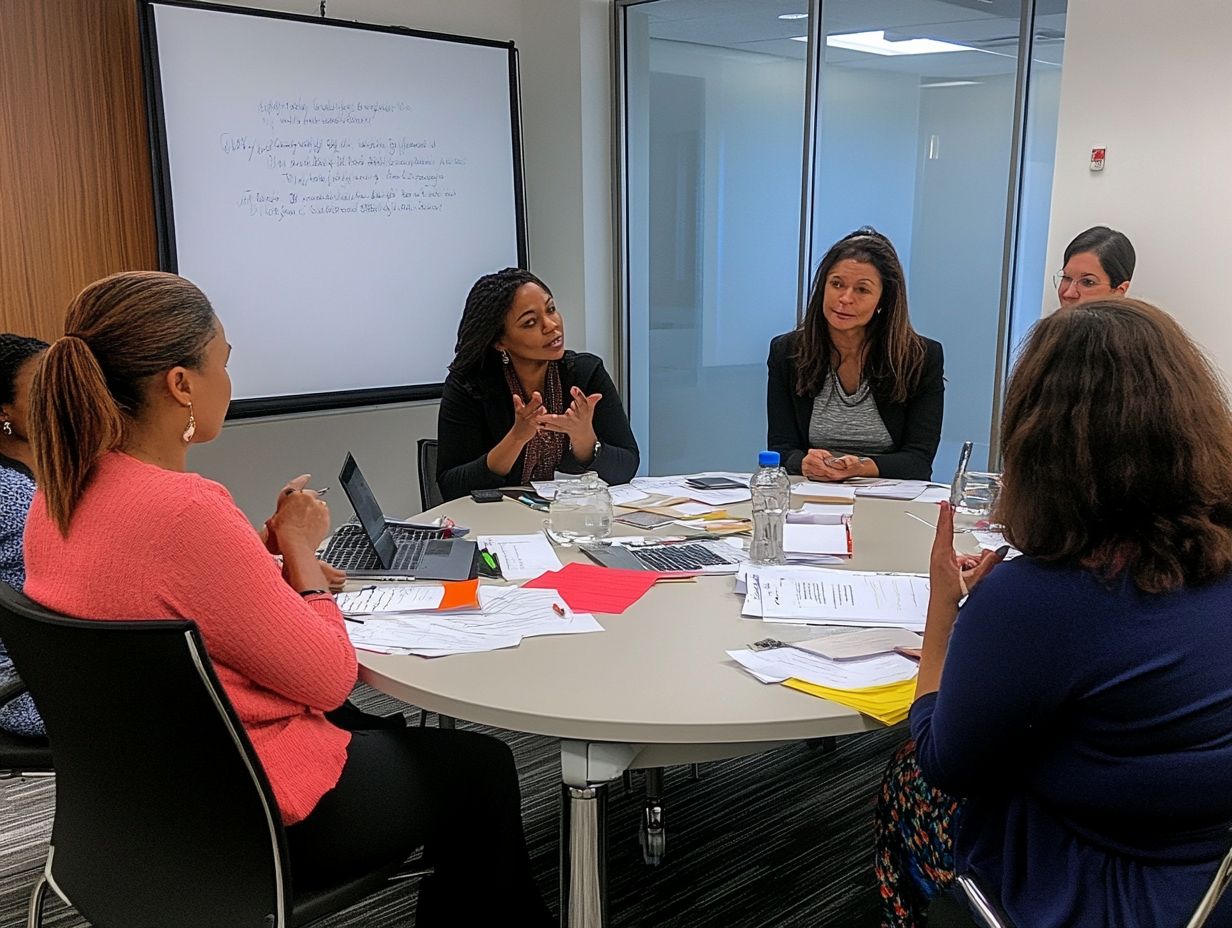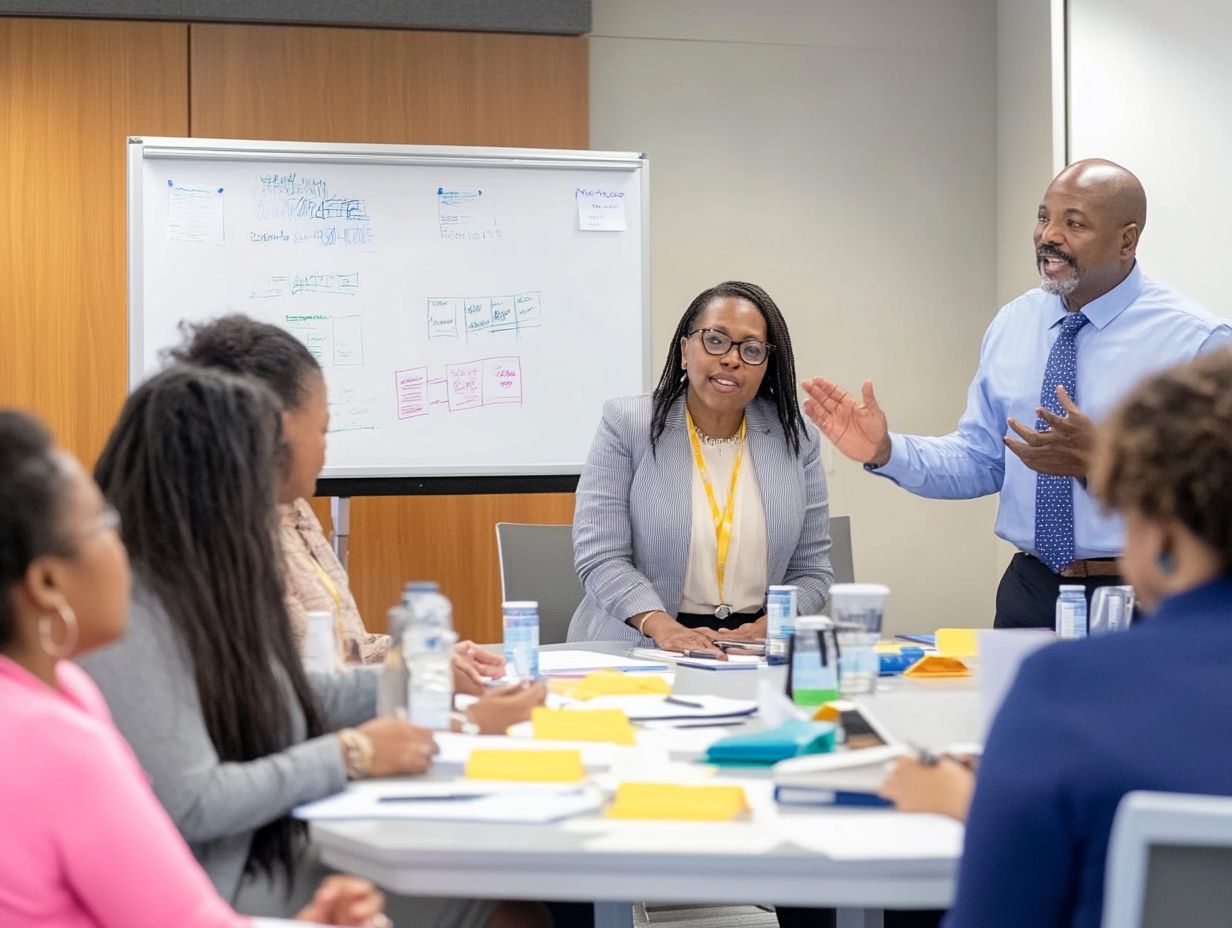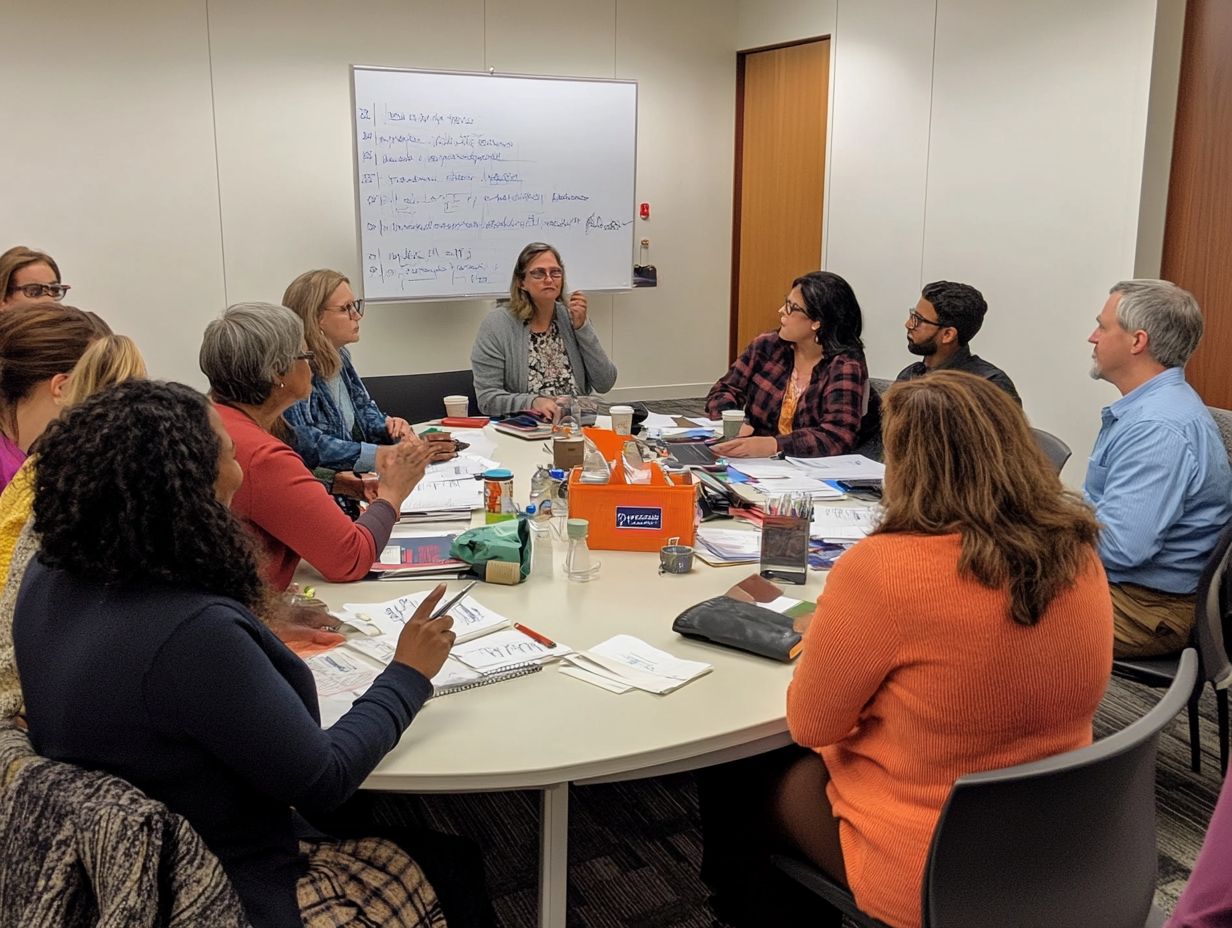5 Ways to Increase Engagement in Leadership Training
In today s fast-paced landscape, effective leadership training has never been more crucial. Yet, numerous programs often falter in capturing participants’ attention.
This article delves into five dynamic strategies designed to elevate engagement in leadership training. These strategies range from interactive activities to personalized feedback, highlighting how real-life examples and group discussions can cultivate a deeper understanding and connection among participants.
Ready to transform your training sessions for maximum impact? Let s dive in to uncover how to craft an inspiring and impactful learning experience.
Contents
- Key Takeaways:
- 1. Incorporate Interactive Activities
- 2. Use Real-Life Examples
- 3. Encourage Group Discussions
- 4. Provide Opportunities for Hands-On Learning
- 5. Offer Personalized Feedback and Coaching
- Why Is Engagement Important in Leadership Training?
- What Role Does Personalized Feedback and Coaching Play in Leadership Training?
- Frequently Asked Questions
- What are the 5 ways to increase engagement in leadership training?
- How can creating interactive activities improve engagement in leadership training?
- Why is it important to incorporate real-life scenarios in leadership training?
- What are the benefits of peer learning in leadership training?
- How can offering incentives increase engagement in leadership training?
- How can technology be used to increase engagement in leadership training?
Key Takeaways:

- Utilize interactive activities to keep participants engaged and actively involved in the learning process.
- Incorporate real-life examples to make leadership training more relatable and applicable to everyday situations.
- Encourage group discussions to foster collaboration and exchange of ideas among participants.
1. Incorporate Interactive Activities
Incorporating interactive activities into your leadership training is crucial for fostering employee engagement and enhancing leadership behavior. To further improve this process, consider encouraging feedback in leadership training. These experiences build a positive connection between engaged employees and their organizational culture. Ultimately, this drives better performance and increases trust among team members.
By focusing on activities that encourage open communication and enable teams, you can build management credibility and promote emotional intelligence among your leaders.
Consider various interactive components like workshops, role-playing scenarios, and simulations to significantly elevate the learning experience. Workshops create immersive environments where participants can tackle real-world challenges. Role-playing allows leaders to practice new skills in a secure setting, and simulations offer hands-on experiences that mirror the complex situations leaders may encounter, fostering deeper understanding and strategic thinking.
These activities also help leaders understand their emotions better and enhance their ability to provide constructive feedback. This approach contributes to more effective leadership development and strengthens the acknowledgment of performance across teams.
2. Use Real-Life Examples
Utilizing real-life examples in your leadership training is a powerful strategy. It vividly illustrates the significant impact effective leaders have on organizational culture, demonstrating how their behaviors can foster innovation, encourage job growth, and boost employee engagement in companies like Microsoft and Airbnb.
Incorporating case studies and real-world scenarios adds depth and makes theoretical concepts more relatable. By examining success stories, you can witness firsthand how specific leadership practices can transform teams and elevate organizational performance.
These insights encourage you to embrace best practices that can lead to amazing results! When leaders observe improvements in employee engagement and a healthier workplace culture through these exercises, they become more inclined to embrace change and implement strategies that resonate with their teams. This enhances the overall learning experience and creates an environment where everyone thrives.
3. Encourage Group Discussions
Encouraging group discussions during leadership training is a powerful way to foster employee engagement and cultivate an open communication environment. This approach is essential for building trust and enhancing leadership skills among participants, as it helps team collaboration and the sharing of valuable insights. Additionally, incorporating gamification in leadership training can further enhance these interactions.
In these discussions, you have the opportunity to voice your thoughts and share personal experiences, creating a space where real challenges can be addressed openly. The dynamics of the group significantly boost performance metrics, allowing you to learn from others’ strengths and weaknesses. Ultimately, this enriches your learning experience.
By incorporating a variety of perspectives, you not only pave the way for more innovative solutions. You also ensure that the outcomes are comprehensive and considerate of diverse viewpoints. This collaborative process ultimately strengthens your leadership team, making it more adaptable and capable of navigating the complexities of today s professional landscape.
4. Provide Opportunities for Hands-On Learning

Providing opportunities for hands-on learning in leadership training significantly enhances your leadership skills by immersing you in real-world scenarios. This active engagement not only fosters employee commitment but also sparks creativity, helping you avoid burnout through the practical application of your skills. For more insights, consider exploring 5 ways to promote skill development in your team for effective problem-solving strategies.
This approach solidifies your theoretical knowledge and builds the key skills needed to thrive in diverse workplace environments. Learning by doing, such as through simulations and workshops, creates a dynamic atmosphere where you can experiment, take risks, and learn from your mistakes in a supportive setting.
By utilizing project management software, you develop critical skills in organization and collaboration, which further enhances your understanding of your emotions and those of others. Engaging in feedback sessions during these hands-on activities promotes open communication, allowing you to adapt swiftly to shifting circumstances and deepening your ability to navigate complex interpersonal dynamics.
5. Offer Personalized Feedback and Coaching
Offering personalized feedback and coaching during leadership training is essential for your development as an effective leader. This approach addresses your individual needs and enhances employee well-being while building trust. The result? A noticeable improvement in performance recognition and the cultivation of emotional intelligence.
Tailored coaching sessions provide you with a unique roadmap, allowing you to identify your specific strengths and weaknesses. This customized strategy fosters self-awareness and encourages a growth mindset, enabling you to take ownership of your learning journey.
Ways to give and receive feedback create an ongoing dialogue between you and your coaches, facilitating continuous improvement. As you evolve as a leader, your new skills lead to a stronger team, fostering a more cohesive workplace culture.
Ultimately, with focused support, you become more adept at navigating challenges, inspiring your team, and driving collective success.
Why Is Engagement Important in Leadership Training?
Want to know why employee engagement matters in leadership training? Employee engagement is essential for your leadership training; it not only propels organizational success but also enhances key performance metrics, builds management credibility, and fosters job growth. Research from Gallup underscores that engaged employees significantly boost workplace productivity and morale, especially when understanding emotions is prioritized in training programs.
This level of engagement weaves itself into your organizational culture, crafting an environment where innovation flourishes and employees feel truly valued. For example, Gallup’s findings indicate that organizations with high employee engagement rates experience a remarkable 21% increase in profitability.
Leadership programs that effectively nurture engagement elevate employee satisfaction while minimizing turnover, which can cost companies up to 200% of an employee’s salary. Remember, effective leadership goes beyond managing tasks; it’s about inspiring your teams to connect with the company’s vision, driving performance metrics upward, and ensuring sustainable growth.
Discover How Interactive Activities Can Transform Your Leadership Training Experience!
Interactive activities in leadership training present a wealth of advantages for you, including better employee involvement, refined leadership skills, and bolstered management credibility.
These experiences enable your team and spark creativity through collaborative learning. Activities such as role-playing scenarios, group discussions, and team-building exercises create a vibrant learning environment that captivates attention.
By placing you in real-life situations, these activities allow you to practice decision-making and problem-solving in the moment, enhancing your retention of vital concepts.
When you incorporate game-like features like simulations or challenges, you significantly amplify motivation. You’ll witness immediate results and feedback on your contributions, making the experience even more rewarding.
This engaging format leads to increased confidence and overall leadership effectiveness, ultimately paving the way for greater organizational success.
How Can Real-Life Examples Enhance Leadership Training?

Real-life examples elevate your leadership training by offering concrete insights into the practices of effective leaders. They illustrate how decisions shape organizational culture and foster innovation, as emphasized in studies by Gallup that highlight the crucial role of emotional intelligence the ability to understand and manage your emotions and those of others in successful leadership.
These case studies are not just educational tools; they are wellsprings of inspiration for aspiring leaders. By diving into the successes and challenges faced by industry pioneers, you can extract invaluable lessons on conflict resolution, team dynamics, and strategic thinking.
For instance, the leadership styles of iconic figures like Simon Sinek or Indra Nooyi can inspire you to adopt philosophies that prioritize collaboration and a growth mindset. Ultimately, witnessing how these principles manifest in real-world scenarios deepens your understanding and enables you to embrace innovative strategies and cultivate resilient, adaptive organizations.
What Are the Advantages of Group Discussions in Leadership Training?
Group discussions in leadership training offer you significant advantages, such as improved employee engagement, open communication, and enhanced team collaboration.
They also play a crucial role in building trust and contributing to your professional development. By fostering a safe environment where you feel comfortable sharing your thoughts and experiences, these discussions encourage openness and vulnerability.
When you express your diverse opinions, you introduce unique perspectives that can pave the way for innovative solutions to complex challenges. This collaborative approach sharpens your critical thinking skills and strengthens the collective knowledge base, allowing everyone to learn from one another.
When differing viewpoints are respected and considered, it reinforces a culture of inclusivity, making it easier for you and your colleagues to contribute to the decision-making process. Ultimately, this leads to shared success for everyone involved.
How Can Hands-On Learning Improve Leadership Skills?
Hands-on learning significantly enhances your leadership skills by immersing you in real-world situations. This approach not only boosts employee engagement but also nurtures your emotional intelligence, helping to mitigate burnout and recognize performance.
By incorporating methodologies like role-playing and simulations, you can dive into scenarios that closely reflect real-life challenges. These engaging activities spark your critical thinking and creativity while creating a safe space for you to experiment without fear of failure.
As you navigate complex situations, you gain invaluable insights into your decision-making processes and interpersonal dynamics. This experiential learning ensures that theoretical concepts seamlessly evolve into practical skills.
Don’t miss out on the chance to strengthen your leadership skills! Ultimately, you’ll walk away from the training equipped with the confidence and competence to apply what you’ve learned in your daily interactions.
What Role Does Personalized Feedback and Coaching Play in Leadership Training?
Personalized feedback and coaching are essential in leadership training. They cater to your unique needs and enhance your well-being. This approach not only improves performance recognition but also deepens your understanding of emotional intelligence.
These strategies help develop important skills while fostering a culture of trust and open communication. Try techniques like role-playing, peer reviews, and one-on-one mentoring to boost your skills!
Ongoing support enables you to navigate challenges with confidence. It builds resilience and adaptability. Continuous support helps you grow and encourages reflection on your experiences, giving you deeper insights into your leadership style and its impact within your team.
Frequently Asked Questions
Here are common questions about enhancing leadership training:

What are the 5 ways to increase engagement in leadership training?
The 5 ways to increase engagement in leadership training are:
- Creating interactive activities
- Incorporating real-life scenarios
- Providing opportunities for peer learning
- Offering incentives
- Utilizing technology
How can creating interactive activities improve engagement in leadership training?
Creating interactive activities allows participants to engage actively in the learning process and apply their knowledge in a fun way. This boosts motivation and helps you remember information.
Why is it important to incorporate real-life scenarios in leadership training?
Incorporating real-life scenarios helps participants understand the practical applications of the skills being taught. It provides the opportunity to practice and receive feedback in a safe environment.
What are the benefits of peer learning in leadership training?
Peer learning allows participants to learn from each other’s experiences, perspectives, and insights. It promotes collaboration and teamwork, essential skills for effective leaders.
How can offering incentives increase engagement in leadership training?
Offering incentives, such as certificates or rewards, can motivate participants to engage actively and put forth their best effort during the training. This creates a sense of healthy competition and makes learning more enjoyable.
How can technology be used to increase engagement in leadership training?
Technology can create interactive and engaging learning experiences, such as virtual simulations, online quizzes, and video tutorials. It also provides a platform for participants to connect and collaborate even after the training.
Explore more about leadership training or sign up for a program today!






